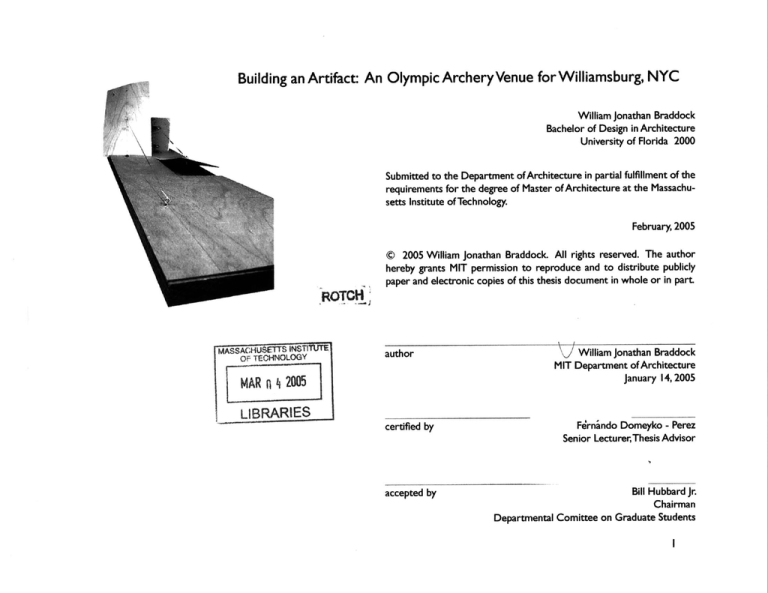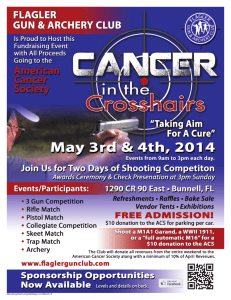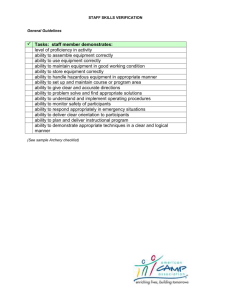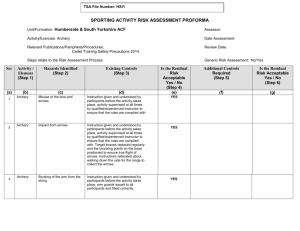NYC
advertisement

Building an Artifact: An Olympic Archery Venue for Williamsburg, NYC William Jonathan Braddock Bachelor of Design inArchitecture University of Florida 2000 Submitted to the Department of Architecture in partial fulfillment of the requirements for the degree of Master of Architecture at the Massachusetts Institute of Technology. February, 2005 @ 2005 William Jonathan Braddock. All rights reserved. The author hereby grants MIT permission to reproduce and to distribute publicly paper and electronic copies of this thesis document in whole or in part. ROTCH ~SSACHUSM1S INSlTWTE OF TECHNOLOGY MAR I author I \J William Jonathan Braddock MIT Department of Architecture January 14,2005 E 2005 LIBRARIES certified by Fdrnindo Domeyko - Perez Senior LecturerThesis Advisor accepted by Bill Hubbard Jr. Chairman Departmental Comittee on Graduate Students Thesis Readers: Tim Eliason - Engineer/TriPyramid Structures Inc. Michael Boucher - Landscape Architects/Michael Boucher Landscape Architecture Building an Artifact: An Olympic Archery Venue for Williamsburg, NYC by William Jonathan Braddock Submitted to the Department of Architecture in partial fulfillment of the requirements for the Degree of Master of Architecture at the Massachusetts Institute of Technology February, 2005 ABSTRACT Every four years, cities throughout the world compete for the right to host the Olympic games. The competition is vigorous because the rewards - in terms of increased visibility on the world stage, are perceived to be great. For many cities, hosting the Olympics means more than just introducing the most prestigious and exciting sporting event to the world but it offers the prospect of new athletic facilities, infrastructure and a new identity. In the summer of 2005, New York City will learn whether it has been selected as the host city for the 2012 Summer Olympics. It is in competition with 3 other cities that all maintain a current prominence on the international stage and all have a master plan to distinguish themselves. For NewYork, the strategy is to distribute the venues around the boroughs in an effort to stimulate growth and development in some of it's most critical areas. This plan makes it possible for neighborhoods within the overall urban context of the city to benefit from the tourism and economic trigger that the Olympic games will bring. It also provides the opportunity for these neighborhoods, some of which have been cut off from the city due to poorly maintained infrastructure and little or no access to be reconnected. This thesis is an attempt to magnify the master plan of the New York City 2012 Olympic proposal to the scale of a neighborhood in Williamsburg. It identifies the East River Waterfront as the site of specificity and proposes to design an artifact for the community using the archery venue as a programmatic generator. Thesis Supervisor: Fernando Domeyko Perez Title: Senior Lecturer in the Department of Architecture I would like to acknowledge the many people that have in some way shape or form contributed to this thesis as well as my education here at Acknowledgments MIT. I count it aprivilege to have been in the company of such talented and ambitious individuals. To Fernando Domeyko. Your passion for architecture is unmatchable and I am lucky to have had the opportunity to work with someone of such integrity this semester. Your vision for my project as well as your willingness to pursue all avenues of design with me is what made this semester bearable and innovative. My thanks to you. To Maggie Adler for your time and participation in my project. Thank you for being my archery consultant and most of all for putting me in touch with the many archers that you did. Your expertise regarding the sport made the project so much more insightful than thrilling to work on. To Tim Eliason and Michael Boucher. Thank you both for being such critical readers for this thesis. Thank you for consulting me and being available. Your insistence on tackling the issues was my motivation to treat this project as a real and buildable project. My thanks to you. Chapter I - Motivations Chapter 2 - Introduction 2.1 - Neighborhood Descriptions 2.2 - Olympic Precedents 2.3 - Economic Potential 2.4 - Summary Chapter 3 - Archery 3.1 - Archery in the Olympics 3.2 - Archery Venues of the Past 3.3 - Programmatic Agenda for the Venue Chapter 4 - Building an Artifact 4.1 - Program 4.2 - Archery as an Art form 4.3 - Occupiable Topography 4.4 - Structural Surface Chapter 5 - Final Proposal 5.1 - An Urban Archery Venue 5.2 - Conclusion Image Credits Bibliography Chapter I - Motivations For a while now, I have been intrigued by the idea of designing for the passage of time. I find myself taking notice of materials that age and buildings that in their own subtle ways seem to draw more attention to their surroundings than to themselves. This thesis has been an active endeavor for me to predict what the next life cycle for a site will be. It has enabled me to exaggerate the notion of sustainability as a device for thinking long term and to embrace the relics of the past. Although this thesis takes it's cue from the Olympic Games, it privileges the local identity of a neighborhood that, for many years, has been cut off from its waterfront. This thesis doesn't attempt to be the solution for a community in need, but rather suggests how to think about an investment in the landscape. The Olympics came to mind last year when I learned that NY was in the running to be the host city. I attended an exhibition of proposed Olympic venues and was amazed at how innovative some of the designs were. When I looked into the projects more in depth I found that they were located in different areas with in the city,that they were conceived to be in array of scales, and more importantly they were introducing new and contemporary strategies for the urban landscape. For me, the Olympics had always been a once in 4 years sporting event that took about 2 weeks of television coverage and only showed the sports that the U.S. seemed to excel in. Seeing the exhibition, I learned that there were more sports and more possibilities for small venue design. My hope was that this thesis would be a new territory of concentration and that through the observation of history, program and context, a new way of occupying the urban landscape could be proposed. A A /I I, ~ / / b / / / / ),Ii/4 J7 :1! .... ............. . ........... .......... ..... ... . ..... .. Chapter 2 - Introduction ........................................ ........ 2.1 Neighborhood Description The East River section of Williamsburg is aforgotten territory. It's history is etched into the landscape and buried under layers of artifacts and ruins of dilapidated warehouses. It iswhere chain link fences mark the edges of land that was once thriving with activity,and where strips of dirt and discolored grass are the only evidence of old rail road tracks. It is a community that survived on waterfront industry for 300 years and stands today as a neighborhood mired by it's history. It's story is one of accelerated growth cut short by changing demands and unfortunate timing . It's waterfront was retrofitted to accommodate the demands of the civil war era and has evolved over the years to suit industries that can make use of it's existing infrastructure. The unregulated industry that began in the 1800's left a lethal mark in the community, the worst offender being the oil refineries and oil storage tanks. In some parts of the neighborhood, hazardous wastes and discharge have contaminated the soil and the waterways making it virtually Impossible to occupy. Williamsburg boasts the largest underground oil spill in the country, (17 million gallons encompassing about 52 acres, in the form of an underground lake) and a trash infested coast line characterized by disintegrated docks and a poorly maintained ecosystem. Rrst Impressions of the site 9 Artifacts = Objects and Markings I 1~\ 1< A>' -- 5~ 'It ~ -I N *2' I A / I. Subway Routes Primary Truck Routes 4 ii I p. IN Landmarks m Toxic Release Inventory Sites Waste Stations Underground Ol Spl <I 7 ~yI /1 * 1~ - Zanin for Hmy Induwy A 4es - Zonkig for Cwmmercil Use - Zoningfor Aved Use 2.2 Olympic Precedents The ancient Olympic games were far different than what we know them to be today. There were fewer events, only Greek speaking men could compete and they were always held at Olympia. Since the rebirth of the Olympics in 1896, the games have changed locations every four years and the number of sporting events has increased from 9 - 28. In addition the games, the venues themselves have evolved from sport specific competition arenas to multi plex stadiums capable of housing multiple events and in some cases at the same time. Although these massive venues create opportunities to implement the most innovative technologies and emerging materials, their use after the games has become insufficient One example of this phenomenon is the $300 million skating facility built for the 1998Winter Games in Nagano,Japan. Today, it is an empty venue that has been converted to a baseball field for the area's recreational league teams. Taxpayers contribute some $1.2 million annually toward the $4 million price tag of maintaining the facility, which is primarily used for conventions and exhibitions from April through September. London Highbury Stadium This stadium located in the suburbs of London was previously used for the London Arsenal soccer team. Due to the team's change in location, the stadium has been converted into housing in which the existing soccer pitch has been retrofitted for gardens. Lofts and flats are located where the grandstands used to be and the exterior facade remains as is to serve as a reminder of the stadium's previous life. 2.3 Economic Potential and Costs An event as large and complex as the Olympics inevitably affects the economy of the host city in multiple ways. However, the degree to which the games can affect small neighborhoods will vary and will do so in time. In an analysis conducted on the economics of the Olympic games, the biggest impacts on a city before, during and after the games were: Investments and expenditures by organizations involved with the preparation and staging of the games Spending by people who visit NewYork to participate in or attend the Olympic events Indirect and induced impacts Induced tourism Induced purchases of goods and services The impact of other amateur sports activities Induced investment Productivity effects Neighborhood development impacts Regarding the cost and concerns at the neighborhood level, tourism and local development via new construction and infrastructure would be the biggest contributors. Approximately 2 million people would visit New York as participants in the Olympics and from that figure, approximately 20-30,000 people would come to the smaller neighborhoods as athletes, spectator, and media. NYC2012 also estimates that revenues received by the local organizing committees in connection with the Olympics would total $2.330 billion, most of which would be derived from the sale of broadcast rights, corporation sponsorships and ticket sales. In addition, $905 million would be allocated to new construction and design. 2.4 Summary In order for the Olympics to take place in New York, the city needs a plan that makes sense locally as well as at the international level. If smaller venues are to occur in the outlying neighborhoods such as Williamsburg, the issues of concern will be venue adaptability for post game use, incorporation of the design with the existing context, an equal balance of tourism with localism and a general sensitivity for the neighborhood's history. At the local level, the specific economic benefits could be the creation of an East River ferry network that would help stimulate private investments in the waterfront, the renovation of existing facilities and the construction of new facilities, such as a proposed waterfront park, and other improvements to the subway station, pedestrian access and streetscape improvements in the vicinity of the games. Aside from all of these potentials, for a venue to effectively translate into an urban amenity for this neighborhood hinges on it's ability to become a part of the landscape itself and to posess a macro strategy as well as a micro vision. Chapter 3 -Archery 3.1 Archery in the Olympics The sport of archery made it's debut as an Olympic event in 1900. At the time, only men were allowed to compete and because it was an unprecedented event, there were no universal rules to govern the competition and the event was suspended. In 1972, the sport re-emerged under a new body of rules and regulations that enabled men and women to compete in separate categoires. Since then, the event has gained recognition and popularity but has maintained it's reputation as a quiet sport. The athletes themselves typically consider the sport to be less of a commitment than others do and hold regular jobs and regular lives for most of the year. Competition for a typical Olympic archery event is more mental than physical and success usually depends on the athlete's calm frame of mind. Spectators are discouraged from clapping, talking and blowing horns during the event to ensure silence and to eliminate unnecessary distractions. In the Olympics, the event takes place outdoors and generally lasts about 6 - 7 hours. The field itself is designed to be split down the middle for men and womens competition to take place simultaneously and a practice field is required to be with in walking distance. The spectators generally number around 5000 and in previous years have been situated behind the archers in an effort to reduce potential distractions. The programmatic requirements for an archery venue call for limited indoor spaces and seem to favor spectator comforts over the athlete services and facilities. 3.2 Archery Venues of the Past For the 1992 Olympics in Barcelona, the archery venue was located on the edge of a mountain and used the landscape as an occupiable space. Since the field itself had to be recessed 6' below grade, it made sense to use the surrounding contours as a literal backdrop for the range itself. Enrique Miralles and Carme Pinos collaborated to design one of the most effective archery venues by remaining sensitive to the landscape while proposing new strategies for indoor athlete spaces. Up until then, the program for an archery venue was barely established, due in most part to the youth of the game as an Olympic sport and because of the proximity requirement that all venues had to be located with in walking distance. Since the games in Barcelona were the first ever to break that tradition, it made sense to provide changing facilities and services for athletes. This design concept was revolutionary in the sense that it suggested how the archery venue could be more than just a surface for competition and instead an occupiable field. It also became the new standard for venues in the future, however it's survival as an icon had diminished and today it has been converted to tennis courts and is relatively unused. -- I - -I 7' - 7 / if /L \ O- 'In Uo In Sydney for the 2000 Summer Olympic games, the archery venue was more of asuccessful collaboration between sustainable efforts and long term goals. It was designed as an elongated roof structure that simply provided shelter for the archers and had relatively no program in terms of services and facilities. In Sydney, the field itself was constructed to float over the wetlands in an attempt to create a permeable membrane of grass and achieve an environmental standard that could be reused in the future. Today,the field isproperly maintained and used as an archery training facility. The venue was one of many in the Sydney Olympics that was designed with apost Olympic plan in mind and today, because of it's existence, the sport of archery has survived in a country with little or no record of previous success in the sport. 68 III i't. 'II G *1 Chapter 4 - Building an Artifact 4.1 Program For an archery venue to be converted into a usable facility inWilliamsburg, a strategy must be implemented that acknowledges the cities history as well as it's potential in the future as a waterfront esplanade. The archery program for this site was flexible in terms of square footage and space requirements primarily because it was sharing the location with the beach volleyball venue. Since the archery venue was open to proposal, my thesis began by thinking of the venue as an artifact that would remain after the games were concluded. Through it's design and layout, the program could be though of as surfaces both above and below that would either house athletes or spectators. As a general proposal, the venue had to satisfy these requirements: Security Access from the water for athletes Access from the neighborhood for spectators Concessions Coaches Stations Media and Broadcast booths Locker Rooms Bathrooms The first design phase of the thesis was to articulate the grids of the neighborhood against the dimensions of two archery fields. Several models were produced to suggest potential site strategies as well as to propose ways that the geometries could re connect the neighborhood with the waterfront 4.2 Archery as an Art form 'The importance of the bow in human history can hardly be overstated, but once man learned how to bend a length of wood back in order to propel a projectile through the air, human life changed enormously." G.Cameron Hurst IlIl, Swordsmanship and Archery The root of this project was to establish a process of making that would articulate the physics of the sport. At full span, the upper part of the body is in complete tension and in order to use this as a generative mechanism for design, my thesis began by creating tension in materials. More specifically,the concept of maximizing wood's potential to stretch and torque into a shape using cables became a structural metaphor for the project. Like the bow, the wood's tendency to hold shape depended on the amount of slack in the cable. By using the cables as a form making device, the wood behaves like a surface being manipulated by a force other than itself. Taking that idea one step further by introducing another material like concrete to act as a fixed point, the surface can be braced thus becoming more structural and more flexible. With a concrete wall as a stop, the cables have the ability to pull the surface into a shape that can bend, flex and contort around it. By doing this, the potential for both predictable and unpredictable spaces can emerge in the surface. This was the departure point for my thesis and the following models describe the experiment further. 4.3 Occupiable Topography As a site strategy, the surface itself was thought of as an artificial terrain that would reflect the shapes, sizes and contours of the various fields of play. The archery fields needed to be located close enough to one another so that access to and from would be permitted. Their sizes measured 100 meters by 90 meters for the competition range and 50 meters by 45 meters for the practice range. By thinking of the site as an artificial terrain, the venues could become part of the landscape but exist as their own entity - in some cases floating above and in others extending from within. According to the NYC2012 Archery regulations, both fields had to be oriented due north in an effort to ensure that the sun would remain behind the archers during competition. By forcing the fields to face north meant that the view from the site would be up river, thus providing visual access to midtown Manhattan and allowing the site to be activated by two fields of continuous play. As a surface condition, the site as a terrain provided an opportunity to respond to the environmental conditions present in the ground and to justify the archery venue as an occupiable topography. s M 100 M Target Line -Mens E Range E Womens Range Waiting Line Shooting Line Competition Field Practice Field 1 -N opow _x 4.4 Structural Surface In an effort to create a topographical relationship between the surface and the intervention, my strategy was to begin molding the site into shapes that could hold their form structurally. Paper models were used to exaggerate the forms into curved membranes that yielded to an opening somewhere in the surface. The progression of the models began to show that the shapes themselves, if held in place properly could become landscape extenders that challenged the definition of interior space and exterior space. The models also suggested that any shape could be informed by a fixed point Therefore by electing a consistent point of resistance in the surface, a continuous form would be achievable. In this case, a simplified shape that existed in between the two fields as a medium for both the archers and spectators was implemented. The goal here was to utilize the orientation of the archery venue as an reason to direct spectators out to the water but though the venue. By configuring the path from the entrance to the water, spectators were given views of both the competition and practice ranges as well as to the waterfront The massive shape of the venue merely directed their vision and became a testament to the monumentality of a material stretched to maximum tolerance. For the spectators, moving through this venue put them in direct contact with the cables in full span and served as a testament to the eloquence of the sport through an occupiable gesture. Models like these became a foundational approach to manipulating the landscape into a surface. By using paper and then plywood as a malleable terrain, shapes and contours could be easily formed and controlled. Spaces could be identified by tracing the edges of the envelope and through the intersection of planes. Programmatic as well as visibility relationships were created through this strategy of bending and folding space. .......... ....... ............ Chapter 5 - Final Proposal . 5.1 An Urban Archery Venue This venue, partially due to it's site location as well as orientation creates a new and usable esplanade along the water. According to the NYC 2012 post Olympic plan, the site will remain greenspace and two of the blocks have already been purchased by NYU to be used as athletic fields. At the conclusion of the games, this venue will translate into a space for sports and locker rooms in the lower levels will support athletes. Entrances from below ground that are now used for archers will be used for athletes of all sports to create ease of access to and from the service spaces to the fields. Garden spaces that reconnect the existing fabric of the neighborhood will serve as street extenders and dissolve into new and refurbished docks at the edge of the river. A new elongated pedestrian walkway will extend along the waters edge and will be broken by the island like archery field. The entrance to the site will be an announced procession from the streets of Williamsburg to the river. There will be no parking on the site specifically to encourage pedestrian activity and eliminate the need for any more wasted concrete space. The site itself will remain barren as a tribute to the industrial history of the neighborhood. The existing artifacts will be used as markers to identify how much time has passed. As a new amenity for the community,this venue will exist as an artifact itself. It will create a new path from the sidewalk to the waterfront and provide pedestrians with an urban promenade that memorializes the passage of time. 0 9/ Vza 0 067 e Co 0 -v/ 12 N V / A: 7~ V / K N V $ ARCHER ACCESS ATHLETE ENTRY VOLLEYBALL ACCESS C6MPETIT1ON fELD 7IHTE l I L----- <N ATHLET LEVE 74 COMlETITIO.FfELD. PRACTICE RIEL- SPECTATOR LEVEL -~ ~?rny-. - 4E 57 4t4 CO I, / 59 5.2 Conclusion To design an archery venue is to redefine the way the sport can be watched and played simultaneously. In today's game, the archers are lucky if they get to compete on anything more than a converted parking lot. Because the sport is notorious for being silent, the venues typically get overlooked and their potential for alternative uses gets ignored. Through this thesis, I learned that archery is a sport of patience and precision. It requires time, discipline and the ability to overcome overwhelming circumstances. I can only hope that this project isrealized as a tribute to the sport and an attempt to articulate it's elegance through the architecture. L. f"LA 774, I Image Credits *Unless otherwise noted, all other illustrations, photograhs and images are by the author. 1. Sean Hammerle in association with www.billburg.com 2. Nathan Benn "View of Williamsburg, Brookly in association with www.corbis.com 3A. Allies and Morrison Architects in association with www.sportsvenue-technology.com 3B. Allies and Morrison Architects in association with www.sportsvenue-technology.com 4A. Enrique Miralles Architect 4B. Enrique Miralles Architect 5A. Enrique Miralles Architect 5B. Enrique Miralles Architect 6A. Patrick Bingham Hall in association with www.archmedia.com.au 6B. Patrick Bingham Hall in association with www.archmedia.com.au 7A. Patrick Bingham Hall 7B. Stutchbury and Pape Architects 7C. Patrick Bingham Hall Bibliography Books Rigillo, Marina, 1963- Miralles/Pinds : Architettura tra artificio e natura : progetti dal 1984 al 1990 / Roma: Gangemi, c1994. EMBT. Spanish. EMBT : MirallesTagliabue :obras y proyectos / Milano: Skira, c2002. Pin6s, Carme. Carme Pin6s : Some projects [since 1991]. [Barcelona :ACTAR, 1998] The stadium : the architecture of mass sport / Rotterdam: NAi Publishers, 2000. Bingham-Hall, Patrick. Olympic architecture: building Sydney 2000 / Sydney,Australia :Watermark, 1999. Chaplin, Joyce E.Subject matter : Technology, the body, and science on the AngloAmerican frontier, 1500-1676 / Cambridge, Mass.: Harvard University Press, 200 1. Selby, Stephen. Chinese archery / Hong Kong : Hong Kong University Press, c2000. Jackson, Davina. Australian architecture now / London :Thames & Hudson, 2000. Herrigel, Eugen, 1884-1955. Zen in the art of archery / New York :Vintage Books, 1971, c1953. Hamlett-Wood, Michael. Field archery :a complete guide / Michael Hamlett-Wood. London : Robert Hale, 2002. Hurst, G. Cameron, 1941- Armed martial arts of Japan : swordsmanship and archery / G. Cameron Hurst Ill. New Haven :Yale University Press, c 1998. Websites Archery Rules and Regulations http://www.archery.org/clients/fita/web/website.nsf Olympic History http://www.olympic.org/uk/games/index ukasp NYC2012 Olympic Plan http://www.nyc20l2.com New York City Planning Comisison http://www.nyc.gov/html/dcp/home.html Post Olympics http://deseretnews.com/dn/view/0, I 249,250009003,00.html




